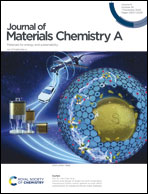A skin-matchable, recyclable and biofriendly strain sensor based on a hydrolyzed keratin-containing hydrogel†
Abstract
The current hydrogel sensors have mostly met diverse requirements including mechanical adaptability, rapid responsiveness and strain sensitivity. However, the wearing comfort, long-term safe integration and environmental friendliness have received negligible attention. Here, a novel type of skin-matchable, recyclable and biofriendly sensor based on a hydrolyzed keratin-containing polyvinyl alcohol hydrogel was reported. The hydrogel demonstrated skin-like mechanical properties of a low modulus, high toughness, superior strength and persistent anti-fatigue-fracture ability (no crack after 1000 cycles) to minimize wearing discomfort and guarantee endurance. A wearable sensor based on the hydrogel conductor possessed ion-transporting behavior close to that of organism, remarkable strain-sensitivity (GF = 4.92) with a low detectable strain of 0.25%, rapid responsiveness, negligible hysteresis and operational durability, which were favorable for providing whole-body motion signals continuously and discerning action status precisely. Notably, the hydrogel sensor had incomparable biocompatibility for achieving safe integration with skin. Furthermore, the hydrogel sensor was fully recyclable, and could be re-used in new electronic devices without sacrificing the original function to prevent the production of electronic waste. It is believed that the simple design concept of this work will provide a new horizon for the development of “green” wearable and implantable electronic devices in the future.



 Please wait while we load your content...
Please wait while we load your content...